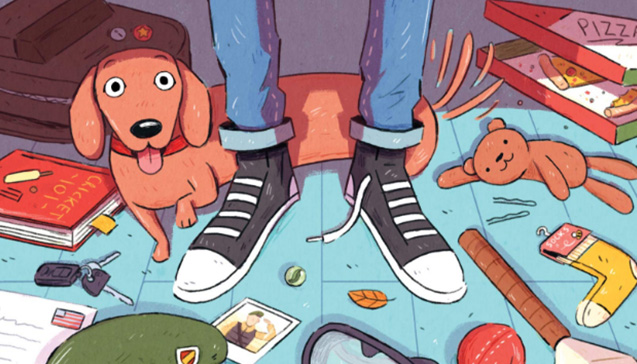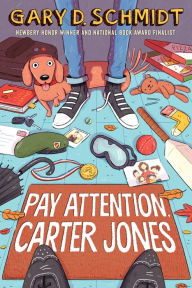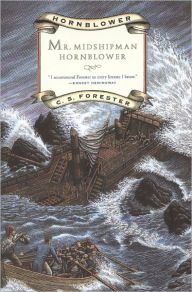A Conversation with Gary D. Schmidt, Author of Pay Attention, Carter Jones, a February Kids’ Book Hangout Selection

Pay Attention, Carter Jones
Pay Attention, Carter Jones
In Stock Online
Hardcover $16.99
Calling all young readers grades 1 through 6! On Saturday, February 2, at 2 p.m., Barnes & Noble will host its third Kids’ Book Hangout, a fun social event where burgeoning bookworms can discover books, participate in activities, and celebrate reading along with other local kids. Attendees can sign up for the event online, and you can find your local store here. We’ve partnered with Houghton Mifflin Harcourt to feature wonderful books for young readers, including Pay Attention, Carter Jones. Carter’s life has been turned upside-down by the sudden absence of his father and the recent death of a younger sibling, but things take a turn for the better (and the more civilized) when he discovers a “gentleman’s gentleman” waiting on his doorstep on the day he is supposed to start middle school. We spoke with the Newbery Honor-winning author, Gary D. Schmidt, about literary inspirations, picking up the pieces after a loss, and the game of cricket.
Where did the idea for Pay Attention, Carter Jones come from?
The idea for Pay Attention, Carter Jones actually came from an imagined image: a butler standing on a stoop in the rain in front of a clearly American suburban home, on the first day of sixth grade for the oldest kiddo who lives there. It’s the incongruity that struck me about that idea: the rain vs. the strictly formal butler, a butler for an American suburban home, a sixth grader who is just entering middle school versus the very formal butler—and on and on. The tensions abound. And of course, the image yields the obvious questions, What is the butler doing there? And though this story could easily have answered this question by tending toward the fantastical, Mary Poppins-y world, I wanted the answer to be very strongly in the realistic world of a sixth grader kid who is hurt with the loss of his brother and, potentially, the loss of his father.
Calling all young readers grades 1 through 6! On Saturday, February 2, at 2 p.m., Barnes & Noble will host its third Kids’ Book Hangout, a fun social event where burgeoning bookworms can discover books, participate in activities, and celebrate reading along with other local kids. Attendees can sign up for the event online, and you can find your local store here. We’ve partnered with Houghton Mifflin Harcourt to feature wonderful books for young readers, including Pay Attention, Carter Jones. Carter’s life has been turned upside-down by the sudden absence of his father and the recent death of a younger sibling, but things take a turn for the better (and the more civilized) when he discovers a “gentleman’s gentleman” waiting on his doorstep on the day he is supposed to start middle school. We spoke with the Newbery Honor-winning author, Gary D. Schmidt, about literary inspirations, picking up the pieces after a loss, and the game of cricket.
Where did the idea for Pay Attention, Carter Jones come from?
The idea for Pay Attention, Carter Jones actually came from an imagined image: a butler standing on a stoop in the rain in front of a clearly American suburban home, on the first day of sixth grade for the oldest kiddo who lives there. It’s the incongruity that struck me about that idea: the rain vs. the strictly formal butler, a butler for an American suburban home, a sixth grader who is just entering middle school versus the very formal butler—and on and on. The tensions abound. And of course, the image yields the obvious questions, What is the butler doing there? And though this story could easily have answered this question by tending toward the fantastical, Mary Poppins-y world, I wanted the answer to be very strongly in the realistic world of a sixth grader kid who is hurt with the loss of his brother and, potentially, the loss of his father.
Mr. Midshipman Hornblower
Mr. Midshipman Hornblower
In Stock Online
Paperback $18.99
What book did you read as a child that made you want to become a writer?
I was a crazily avid middle school reader, and here I think the book most important to me was The Little World of Don Camillo—which I still have on my desk to read in most days. I also read the Horatio Hornblower books as if they were candy corn, and Edith Hamilton’s Mythology, which I bought at the Metropolitan Museum of Art in NYC. An earlier favorite was a set of books called My Bookhouse—a set by Olive Beauport Miller that was marked in the late 1920s by packaging it in, no kidding, a little wood house. And of course, like everyone else, in middle school I was reading Tolkien, which was marketed as “adult fantasy,” a title which led my parents almost to not buy the books for me because they figured it was porn. So, altogether, a sort of strange mix.
Do you have advice for young writers?
Here’s the advice for young readers that is most important: Read. Read everything. Read in your favorite genre, read in all the other genres, read editorials for structure, read plays for dialogue, read poetry for word choice, read novels for characters, read short stories for beginnings and endings and dramatic tension, read graphic novels for visualization—read everything. I teach writing at the college level, and when I start a student’s short story, I can tell within a few sentences if this person has been a reader or not. If the writer has not been a reader, writing must feel as if he or she is learning a foreign language, or as if I’m in an ESL classroom.
How would you describe Carter, the main character of the book?
Carter is a kid who is hurt: his father is AWOL, and his younger brother has died. There is a huge hole in the family, and Carter realizes that he is now the only guy in the house, and he doesn’t know what to do about that. He’s angry, too, and so not really all that excited about this butler who seems to stand in for his father. He is also not the kiddo eager to try something new—though everything about middle school is new. This means that when the butler tries to introduce him to the game of cricket, Carter is not enticed. When you are hurt, it’s easy and natural to hunker down—and this is a kid who is very hunkered down.
What’s your favorite thing about the game of cricket?
What is my favorite thing about cricket? That’s easy: the lovely, amazing, rather unbelievable civility of the game, laden as it is with centuries of rules and formalities. It is astounding that this game, with its “whites” and jargon and decorum and ancient traditions, is so vital in so many parts of the world—even at American colleges and universities. The distinction between such a game and, say, American football, or rugby, or town team soccer, could not be greater, and yet it’s clear that the players are just as intense and just as intent upon clear victory. That tension makes it a fascinating scaffold for a novel about a kid who does not really know where to turn next.
Pay Attention, Carter Jones is on B&N bookshelves now.
What book did you read as a child that made you want to become a writer?
I was a crazily avid middle school reader, and here I think the book most important to me was The Little World of Don Camillo—which I still have on my desk to read in most days. I also read the Horatio Hornblower books as if they were candy corn, and Edith Hamilton’s Mythology, which I bought at the Metropolitan Museum of Art in NYC. An earlier favorite was a set of books called My Bookhouse—a set by Olive Beauport Miller that was marked in the late 1920s by packaging it in, no kidding, a little wood house. And of course, like everyone else, in middle school I was reading Tolkien, which was marketed as “adult fantasy,” a title which led my parents almost to not buy the books for me because they figured it was porn. So, altogether, a sort of strange mix.
Do you have advice for young writers?
Here’s the advice for young readers that is most important: Read. Read everything. Read in your favorite genre, read in all the other genres, read editorials for structure, read plays for dialogue, read poetry for word choice, read novels for characters, read short stories for beginnings and endings and dramatic tension, read graphic novels for visualization—read everything. I teach writing at the college level, and when I start a student’s short story, I can tell within a few sentences if this person has been a reader or not. If the writer has not been a reader, writing must feel as if he or she is learning a foreign language, or as if I’m in an ESL classroom.
How would you describe Carter, the main character of the book?
Carter is a kid who is hurt: his father is AWOL, and his younger brother has died. There is a huge hole in the family, and Carter realizes that he is now the only guy in the house, and he doesn’t know what to do about that. He’s angry, too, and so not really all that excited about this butler who seems to stand in for his father. He is also not the kiddo eager to try something new—though everything about middle school is new. This means that when the butler tries to introduce him to the game of cricket, Carter is not enticed. When you are hurt, it’s easy and natural to hunker down—and this is a kid who is very hunkered down.
What’s your favorite thing about the game of cricket?
What is my favorite thing about cricket? That’s easy: the lovely, amazing, rather unbelievable civility of the game, laden as it is with centuries of rules and formalities. It is astounding that this game, with its “whites” and jargon and decorum and ancient traditions, is so vital in so many parts of the world—even at American colleges and universities. The distinction between such a game and, say, American football, or rugby, or town team soccer, could not be greater, and yet it’s clear that the players are just as intense and just as intent upon clear victory. That tension makes it a fascinating scaffold for a novel about a kid who does not really know where to turn next.
Pay Attention, Carter Jones is on B&N bookshelves now.

